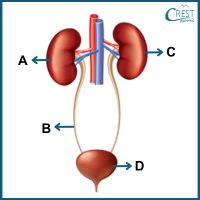1. Consider the following statements and choose the correct option:
Statement 1: The process of transpiration helps in the movement of water from the roots to the leaves.
Statement 2: Transpiration is the loss of water in the form of water vapours through the stomata.
a) Statement 1 is correct but statement 2 is incorrect.
b) Statement 1 is incorrect but statement 2 is correct.
c) Both statements are correct.
d) Both statements are incorrect.
Answer: c) Statement 1 is correct because transpiration indeed helps in the movement of water from the roots to the leaves. Statement 2 is also correct because transpiration refers to the loss of water in the form of water vapour through the stomata on the surface of leaves.
2. A student placed a slice of potato in a concentrated salt solution. After some time, the potato slice appeared to shrink. What caused this?
a) Water moved into the potato slice from the salt solution.
b) Water moved out of the potato slice into the salt solution.
c) The potato slice absorbed salt from the solution.
d) The potato slice released water into the solution.
Answer: b) When a slice of potato is placed in a concentrated salt solution, the salt solution has a lower water concentration compared to the potato cells. This causes the water to move out of the potato cells through osmosis. As a result, the potato slice appears to shrink.
3. The diagram shows the human excretory system. Select the part(s) that filter the blood to remove waste and toxins from it.

a) A and B
b) A and C
c) B and D
d) C and D
Answer: b) A and C. Both kidneys in the human excretory system are responsible for filtering blood and removing waste and toxins from it. Each kidney performs the essential functions of filtration, reabsorption, and secretion to maintain the body's fluid and eliminate waste products.
4. In the following question, you will find an assertion and a reason. Select the appropriate option that applies.
Assertion: The main function of red blood cells is to transport oxygen to body tissues.
Reasoning: Red blood cells contain a protein called haemoglobin, which binds to oxygen and carries it throughout the body.
a) Both the assertion and reasoning are true, and the reasoning is the correct explanation of the assertion.
b) Both the assertion and reasoning are true, but the reasoning is not the correct explanation of the assertion.
c) The assertion is true, but the reasoning is false.
d) The assertion is false, but the reasoning is true.
Answer: a) The assertion is true because the main function of red blood cells is indeed to transport oxygen to body tissues. This is accomplished by the presence of haemoglobin, a protein within red blood cells that binds to oxygen and carries it throughout the body. Therefore, the reasoning is a correct explanation for the assertion.
5. Look at the table below and correctly identify the blood vessels A, B, and C based on their description.
|
Blood Vessel
|
Function
|
Characteristics
|
|
A
|
Carries deoxygenated blood from tissues and organs
|
Thin, less muscular walls
|
|
B
|
Facilitates gas exchange between blood and tissues
|
Very thin walls
|
|
C
|
Carries oxygenated blood to tissues and organs
|
Thick, muscular walls
|
a) A: Veins, B: Capillaries, C: Arteries
b) A: Arteries, B: Capillaries, C: Veins
c) A: Pulmonary Artery, B: Pulmonary Vein, C: Capillaries
d) A: Capillaries, B: Pulmonary Artery, C: Pulmonary Vein
Answer: a) A: Vein
B: Capillary
C: Artery


